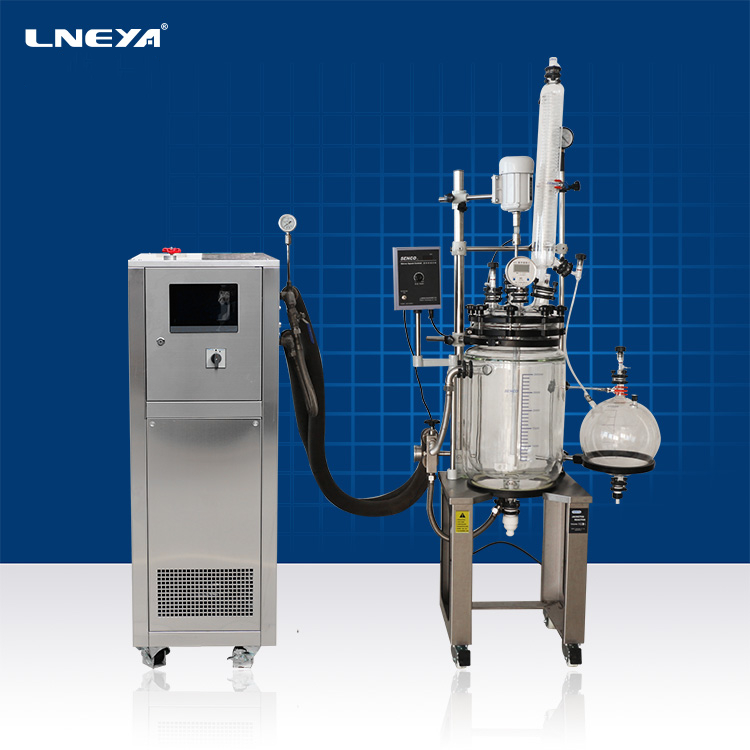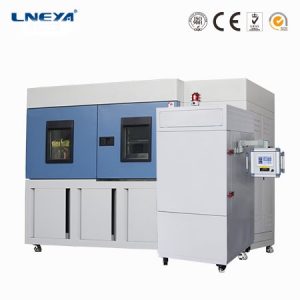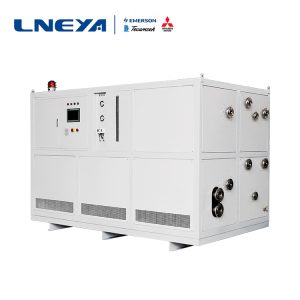Efeito do sistema de arrefecimento e aquecimento no reator de vidro
The glass reactor is compact in volume and clear in structure, and can be conveniently operated in series and parallel in a flexible manner, fully satisfying various process occasions; the reaction path does not have any metal contact, and the inlet and outlet ports use a special conical connector to facilitate the rapid connection of PTFE pipeline In addition, special import and export joints can also be customized according to specific needs. If you use LNEYA’s cooling and heating system equipment, you don’t have to worry about the size of the joint at all. We will match the joint according to your import and export flow.

The inner container of the double-layer glass reactor is equipped with reaction materials, and can be evacuated and speed-adjusted at the same time. The interlayer can introduce freezing liquid, water and high-temperature liquid to heat and cool the materials. It is used for synthesis of new materials in chemistry, fine chemicals and biopharmaceutical Wait for experiment, pilot and production. It can be combined with circulating water type multi-purpose vacuum pump, diaphragm vacuum pump, low temperature circulation (vacuum) pump, circulation cooler, constant temperature circulator, low temperature cooling liquid circulation pump, closed refrigeration heating circulation device, etc. to form a system device.
The temperature range of LNEYA cooling and heating system is -120 ℃ to 350 ℃, with high precision and intelligent temperature control. The ultra-high temperature cooling technology can directly cool down from the high temperature of 300 ℃. Since only the heat transfer medium in the expansion chamber is in contact with the oxygen in the air (the temperature of the expansion tank is between normal temperature and 60 ℃), the heat transfer medium can be reduced. High temperature heat medium will not evaporate at high temperature, and continuous control can be realized in the range of -80 ℃ to 190 ℃.
The glass reactor can be used in a large temperature range from high temperature (300℃) to low temperature (-80℃); it can work under normal pressure and vacuum conditions, and the vacuum degree can reach below 0.095MPa under static conditions. After the reaction of the interlayer cooling or heating solution, it can be completely eliminated without liquid accumulation. Choosing a good temperature control system equipment is inevitable for the reaction process and material testing.
Recomendações relacionadas
-
Vocs unidade de recuperação de condensação de gases de escape instruções de carregamento de refrigerante
1697No processo de recuperação da condensação dos gases de escape vocs, o refrigerante é capaz de afetar o funcionamento do processo de recuperação da condensação dos gases de escape vocs, os fabricantes profissionais do tratamento de recuperação da condensação dos gases de escape vocs lembraram que...
Ver detalhes -
Descrição da fonte de alimentação do chip condutor no sistema de controlo da temperatura de ensaio de chips
1380O sistema de controlo de temperatura de teste de chip é principalmente para o equipamento de teste de fonte de calor frio para vários chips de unidade. Antes da operação do sistema de controlo de temperatura de teste de chips Wuxi Guanya, o utilizador precisa de conhecer a potência do chip de acionamento. I...
Ver detalhes -
Como substituir o compressor scroll do modelo de testador de impacto?
2169Em termos de diferentes modelos de testadores de impacto, a configuração também é um pouco diferente. Entre eles, deve ser tomado um cuidado especial quando a substituição do scroll é um compressor. Se a substituição não for notada, o testador de impacto não pode ser usado. O ...
Ver detalhes -
Instruções de carregamento do refrigerante do congelador com grandes diferenças de temperatura
2040No desenvolvimento da indústria moderna, o congelador de grande diferença de temperatura também é importante no tratamento a frio. Em todo o processo de refrigeração do congelador de grande diferença de temperatura, o carregamento de refrigerante também é mais importante. Então, como é que...
Ver detalhes
 LNEYA Refrigeradores industriais Fabricante Fornecedor
LNEYA Refrigeradores industriais Fabricante Fornecedor













